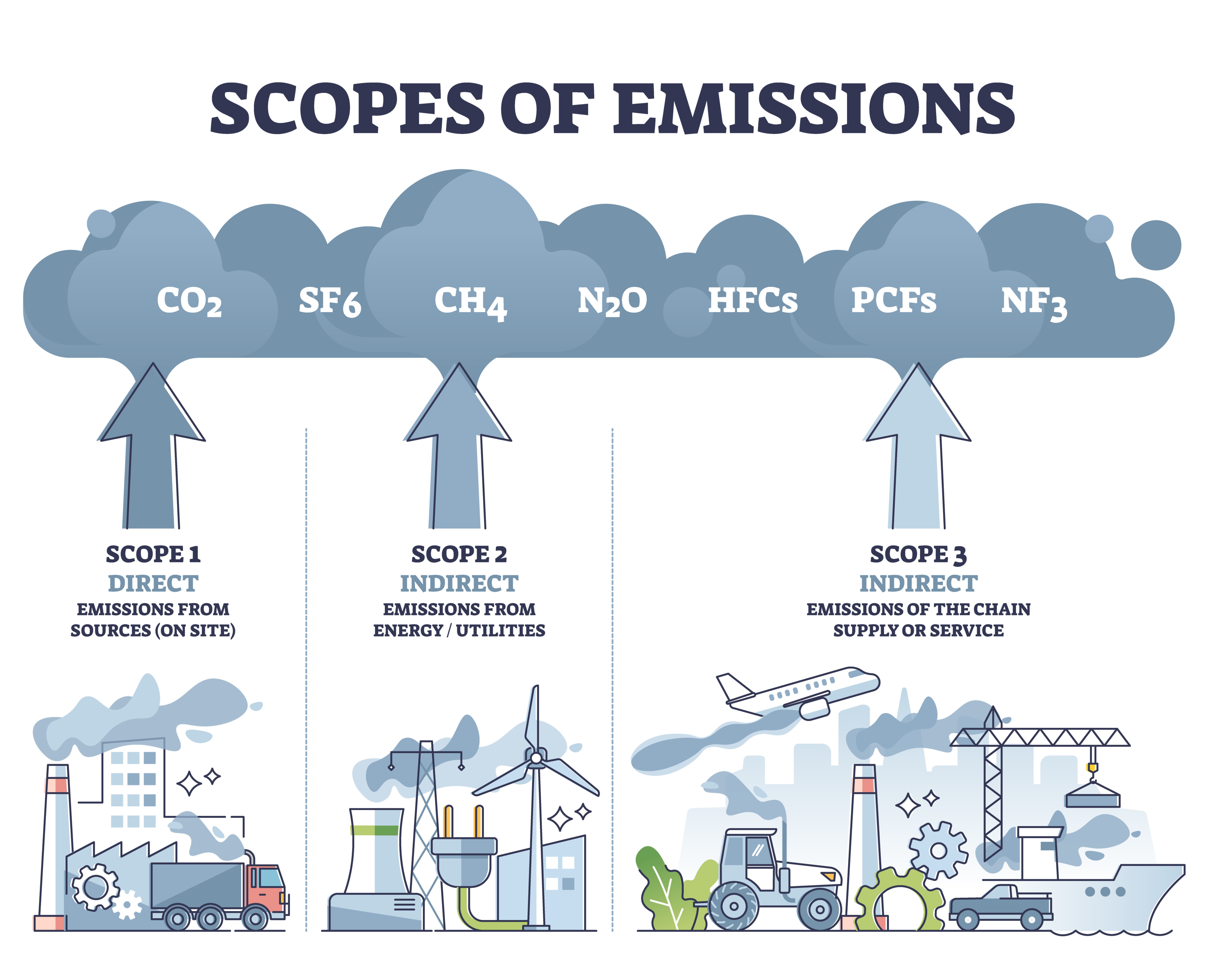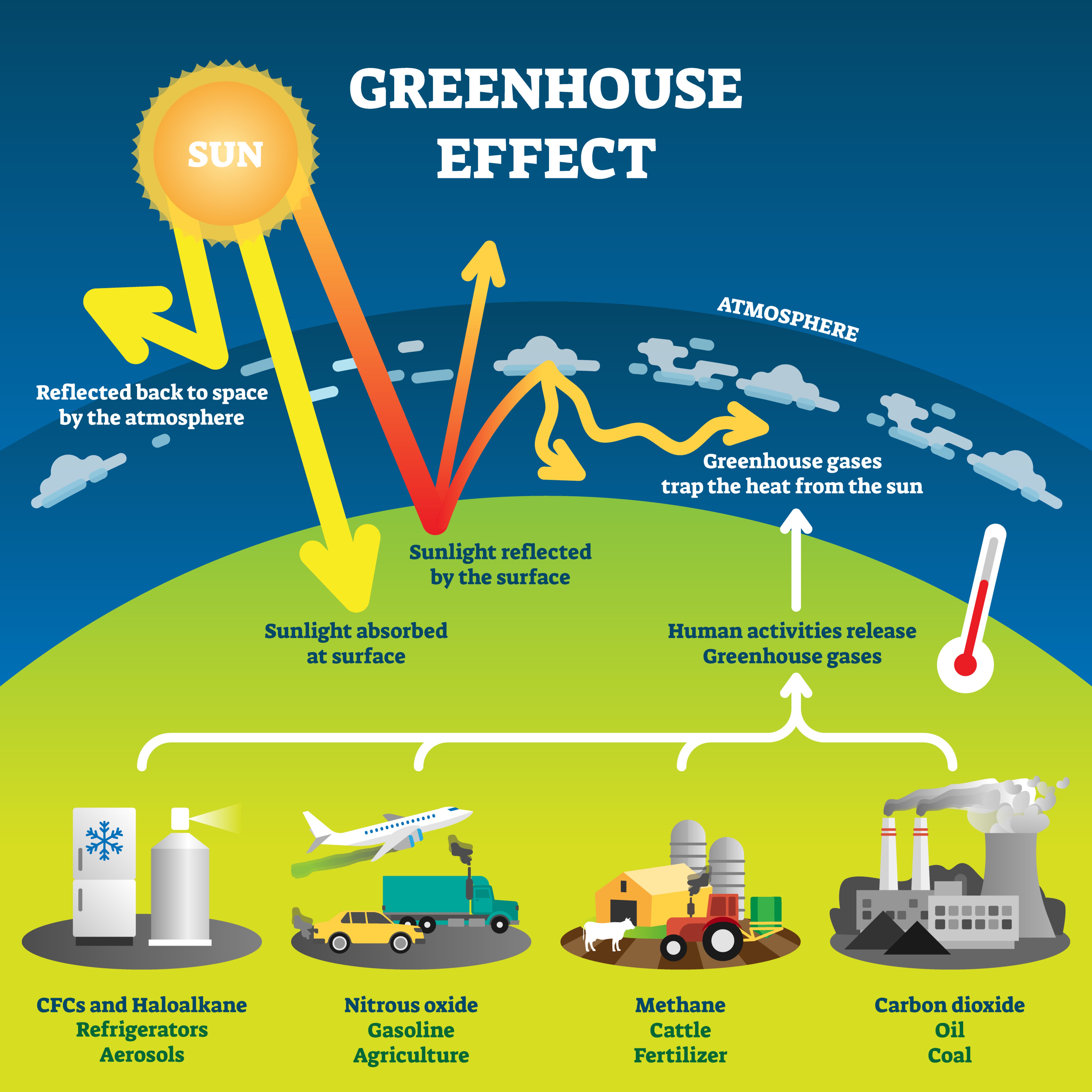Is Your Business Ready to Measure and Report Its Greenhouse Gas Emissions?
Never miss a thing.
Sign up to receive our insights newsletter.

Carbon emissions aren’t just a concern for industrial plants anymore. Businesses are seeing new opportunities instead of just regulatory headaches. Emerging technologies can sequester — capture and lock away — carbon from the atmosphere, and companies with big carbon-reduction projects are taking advantage of the opportunities — the voluntary carbon market — to sell those reductions as carbon credits in an international marketplace. On the regulatory side, the U.S. Securities and Exchange Commission (SEC) has proposed regulations that would require all public companies to report their carbon emissions and other measures of environmental sustainability.
What do you know about GHG emissions and how they will affect all kinds of businesses in the future? Are you ready to seize some new opportunities and prepare for new requirements?
- EPA – US Environmental Protection Agency
- GHG Protocol – Greenhouse Gas protocol
- GHG – Greenhouse Gases
- SASB – Sustainability Accounting Standards Board
- SEC – U.S. Securities and Exchange Commission
What Are GHGs?
GHGs trap heat and reflect it back to the surface of the earth. They act like the glass walls of a greenhouse: The warming rays of the sun penetrate through them, but the gases form a layer around the earth that does not allow heat to escape, trapping the sun’s warmth in the earth’s environment so that, rather than radiating it to space, the atmosphere heats up. The most common GHG is carbon dioxide (CO2), but methane (CH4), nitrous oxide (N2O) and fluorinated gases such as nitrogen trifluoride (NF3), hydrofluorocarbons (HFCs), perfluorocarbons (PFCs) and sulfur hexafluoride (SF6) also trap heat.
GHGs primarily arise from the combustion of carbon-based fuels such as oil, gas, coal and wood. The carbon in the fuel when burned is converted to carbon dioxide and water. Most fuels contain some level of contaminates (that is, they aren’t solely carbon-based), so other GHGs are formed during this process as well. Nitrous oxide results from the use of nitrogen-based fertilizers in agriculture. Fluorinated gases have no natural source and are a direct result of human activities; they are predominately used as replacements for ozone-depleting chemicals. In addition to GHG production from fuel combustion, some other sources include agricultural sources, such as livestock and rice production, and chemical reactions that produce goods from raw materials.
While unregulated, water also contributes to the greenhouse effect.
Emissions of the first four GHGs — carbon dioxide, methane, nitrous oxide and fluorinated gases — have increased rapidly in recent years due to human activity and are non-condensable, meaning they remain gases at typical atmospheric temperatures and pressure ranges. However, water vapor is condensable: It can be converted to liquid or solids within typical temperature and pressure ranges. As the temperature of the earth rises, more water is entering the atmosphere as a gas. Then, when temperatures cool, it precipitates as rain or snow. Record floods or snowfalls are a visible sign that the earth is warming and that more water is entering the atmosphere as a gas.
How Are Greenhouse Gas Emissions Measured?
For regulatory reporting or carbon trading purposes, GHG emissions are converted into CO2 equivalencies and measured in metric tons. Just as currency conversions allow companies in Europe and the U.S. to buy and sell to each other, converting GHG emissions into tons of carbon enables the carbon trading and carbon offset markets to function.
Emissions from carbon-based fuels — gasoline, diesel, natural gas, propane — can be converted to tons of carbon dioxide if the amount of fuel being burned is known. Electricity can be converted to CO2 equivalencies based on the fuel used to generate the electricity, which is useful when looking at either consumption or efficiency/reductions. There are calculators that will provide the conversion for when incandescent lights are replaced with LED lights and for carbon offsets, as well as to convert trees and forest acreage into equivalent tons of CO2 removed from the atmosphere through sequestration.
What Emissions Are Measured?
The Greenhouse Gas Protocol (GHG Protocol) is the leading accounting and reporting standard for GHG emissions. The GHG Protocol uses three “scopes” to delineate the source of the emissions as either direct (scope 1) or indirect (scopes 2 and 3). Direct emissions are from sources that are owned or controlled by the reporting company. Indirect emissions are emissions that are the consequence of the activities of the reporting company but occur at sources owned or controlled by another company.

| GHG emissions that are generated by the company’s boilers, furnace, vehicles or chemical production and process equipment. There are four different types of emissions: stationary combustion (building heat sources), mobile consumption (transportation), fugitive emissions (leaks) and process emissions (manufacturing). | GHG emissions that are generated indirectly, such as the purchase of electricity, steam, heating or cooling that is generated elsewhere. A U.S. Environmental Protection Agency (EPA) directive notes that, while these emissions are not under the control of a company, “they are accounted for in an organization’s GHG inventory because they are a result of the organization’s energy use.” | GHG emissions that occur from assets not owned or controlled by the reporting company. Upstream scope 3 emissions include goods and services that a company acquires, transportation of goods to the company, and employees’ business travel and commuting. Downstream scope 3 emissions are caused by use of the company’s products and the transportation of products after they’ve been sold. |
Who Needs to Measure and Report GHG Emissions?
In the U.S., more than 8,000 facilities are required to report GHG emissions: fuel and industrial gas suppliers, carbon dioxide injection sites and large GHG emissions sources. These are reported to the U.S. Environmental Protection Agency (EPA) through the Greenhouse Gas Reporting Program. Individual states also have reporting rules or guidelines such as the California Low Carbon Fuel Standard (LCFS), which is designed to decrease the carbon intensity (the weight of carbon emitted per energy unit) of California’s transportation fuel pool and has guidance for both reporting and modeling carbon. California is not alone. Twenty-four states, the District of Columbia and Puerto Rico have also established inventories and guidelines associated with GHG emissions.
Several organizations have created standards and frameworks for reporting sustainability and GHG information. The Global Reporting Initiative (GRI) began in 1997 and has been a catalyst for international sustainability initiatives by providing the world with a common language to report their impacts. Another framework for reporting is offered by the Sustainability Accounting Standards Board (SASB), which is now a part of the IFRS Foundation and will become the International Sustainability Standards Board (ISSB). The SASB frameworks guide the financial aspects of sustainability and provide language for how to report sustainability initiatives to investors.
GHG measurement and reporting are not just for industrial plants. On March 21, 2022, the SEC proposed enhanced climate change reporting requirements that would require public companies to provide more robust and standardized climate-related information in their registration statements, annual reports and SEC filings such as the 10-K.
To simplify and standardize emissions reporting, the proposed SEC rules would require companies to express each scope of its GHG emissions in terms of carbon dioxide equivalent (CO2e). This formula is consistent with the GHG Protocol, the Commission says, and will make it easier for investors to compare companies with outputs of different GHGs.
What Do ‘Carbon Neutral’ and ‘Net-Zero Emissions’ Mean?
Two important terms used to describe GHGs include “net-zero emissions” and “carbon neutral.” Often used interchangeably, they do not always mean the same thing, though both terms have a similar goal — to describe a net reduction in harmful emissions to the earth’s atmosphere.
Carbon neutral means that the amount of carbon being removed from the atmosphere equals the carbon emitted by the company. For example, if a company owns a forest that absorbs a calculated amount of carbon dioxide and their manufacturing plant produces the same amount of carbon dioxide, the process would be considered carbon neutral.
“Net-zero emissions” takes this idea one extra step and refers to the amount of all GHG’s produced by the company and the total of all GHG reductions and carbon capture. That is, for a process, a building or a company to be net zero, an amount of GHGs must be removed from the environment equal to those released, or energy must be provided by a zero-emissions source. On a small scale, for example, an office building might install photovoltaic panels that generate as much electricity as the building consumes over the course of the year. The building could then be described as net zero for electricity, even if it is connected to the grid and sometimes uses power from a fossil-fuel utility source.
The real difference between net zero and carbon neutral lies in how the company gets there. Generally speaking, companies buy offsets to be carbon neutral or to claim that a product is carbon neutral. For example, a Rwandan coffee farm chose to use organic fertilizers made locally from waste coffee cherry pulp and processed by black soldier flies. This shift from imported fertilizers to locally produced fertilizers from waste materials reduced transportation emissions and allowed the farm to plant enough coffee plants to offset other emissions and achieve carbon neutrality. Net zero is usually achieved by either efficiency improvements or by adding carbon-free energy sources (wind or solar), with achievement in one metric compensating for emissions in another.
What Is the Voluntary Carbon Market?
Even if a company does everything it possibly can to reduce its “carbon footprint” (total GHG emissions), they are still likely to fall short of net zero or carbon neutrality. This is where the carbon offset market can play a role. There are several groups that work to provide certified carbon offsets that meet strict standards to ensure that carbon offsets are actually reducing carbon emissions. The Verified Carbon Standard, Gold Standard, Climate Action Reserve and the American Carbon Registry work to ensure that the offsets meet standards before credits are issued and sold.
Buying carbon credits requires doing your homework on the source. The source of the credits needs to be verified and validated to ensure that a ton of carbon dioxide equivalents is being sequestered or reduced. Voluntarily purchasing carbon credits provides time for companies to develop technological advances to reduce emissions in-house or on-site. Companies that purchase carbon credits need to be confident in the source of the credits to avoid greenwashing.
What Is Greenwashing?
As the discussion about climate change grows in intensity, so have false claims about being compliant with GHG policies, which has led to consumer skepticism and may have been the reason for the SEC’s call for increased scrutiny and more consistent standards. False claims of this nature are considered “greenwashing.” Greenwashing is a false advertising claim that leads consumers to believe that products are environmentally benign or beneficial, or when a company spends more effort marketing their green policies then actually ensuring sustainable practices. Companies claiming to be carbon neutral or net zero may not be able to substantiate these claims, and consumers and investors are increasingly requiring evidence of compliance.
How Can Your Company Prepare for the Future and Take Advantage of the Opportunities While Ensuring Ghg Emission Compliance?
With growing expectations for thorough and transparent GHG reporting and increasing environmental, social and governance (ESG) risks, companies that are proactive in developing strategy and maximizing the reliability of these metrics will be better positioned to comply with any new requirements. Even companies that are on board with the process may have questions about how to get started.
The GHG Protocol Scopes are a good place to start. Understand your emissions in terms of Scopes 1, 2 and 3 and evaluate how far away you are from net zero. This will help you make good decisions about purchasing carbon credits in the short term, while implementing emission-reducing technology for the long term. Follow Weaver’s series explaining GHG Protocol Scope emissions to learn more about scopes 1, 2 and 3 and how they apply to your company.
How Weaver Can Help
Whether your company is just beginning to consider the benefits of getting involved in green energy segments or you’re a current player seeking to expand your markets, Weaver has the perspective and capability to help you succeed.
The environmental programs we assist with are rooted in managing the human impact on the environment, reducing GHG emissions and increasing sustainability.
Our team of energy professionals brings a wide variety of backgrounds to help clients solve problems. In addition to the CPAs you would expect, for example, we employ registered professional engineers, chemists and environmental lawyers. They combine long experience in traditional oil and gas with up-to-the-minute understanding of emerging renewable markets.
Within the renewable fuels industry, our Energy Compliance Services team is a dominant force, helping businesses navigate compliance with regulations from agencies such as the EPA, Environment and Climate Change Canada, U.S. Customs and Border Protection Agency and the California Air Resources Board, as well as various other states and provinces. We help companies of all sizes understand regulatory requirements, maintain corporate compliance, and identify and maximize benefits that might be available under “green” programs.
Many of the world’s leading domestic and global energy companies, across all segments of the industry, are our clients. We understand the regulatory and technical issues related to sustainable or low-carbon energy as well as the financial issues involved in carbon sequestration tax credits and green finance.
©2023
Upcoming articles will take a deep dive into the three different types of emissions, called “scopes” used to delineate direct and indirect sources of greenhouse gas emissions.


